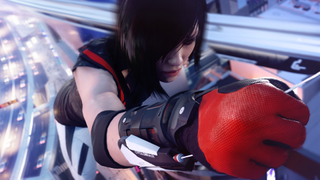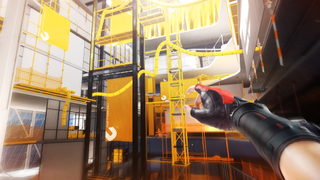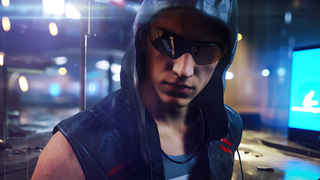Mirror's Edge Catalyst looks like the sequel I was hoping for

I'm in a behind-closed-doors presentation of a mission from Mirror's Edge Catalyst, and I've already lost count of how many times the word "fluidity" has been said. The movement? Fluid. The combat? Fluid. The mission structure? Fluid. The way the engine can now seamlessly transition from the outside world into a building's interior? Yup, also fluid. It's subtle hints like this that convey DICE's intent for their game.
I sympathise with the repetition, because Mirror's Edge Catalyst isn't dramatically different from its predecessor. Yes, there's an open world now, but the basic tenets of what made Mirror's Edge so good are all present in the demo. It looks gorgeous, just as Mirror's Edge did. Its freerunning seems responsive and satisfying, just as Mirror's Edge's was. When Catalyst was announced, DICE claimed it wasn't a sequel. Here it looks like the most typical of sequels; improving the first game's best features and tweaking its worst. In short, it's Mirror's Edge but more fluid. It's pretty much exactly what I was hoping for.
"I really think that we have managed to take what was so good about Mirror’s Edge, such as the first-person movement and the unique art style, and make it better," says senior producer Sara Jansson in an interview after the presentation. "We've added some new elements to it along the way, and removed some of the irritations of the first game as well."
Opening the map screen, Faith places a marker to the mission's starting point. This activates runner vision—the red object highlighting that, in Mirror's Edge, showed players the optimum route. In Catalyst, it does the same thing, but is applied on the fly based on where your waypoint is set. As in the first game, it's also optional. Our target is the looming building of Elysium, and it's clearly visible in the distance for those who want to make their own way.

Transitioning to an open world has had a marked effect on Catalyst's design. "We had to make changes to the movement system to adapt to a freer environment," says Jansson. "One example of that is, while in the first game you could only springboard from certain objects, in Mirror’s Edge: Catalyst you can springboard from any object of a certain height. That adds to the freedom."
DICE also had to shift their development pipeline. "We had to learn how we design spaces to be fun to traverse in different directions," says Jansson. "The artists and the designers have to work really closely together. Every object in the environment is not there just to be pretty, it’s there because it’s something you interact with."
On the way to Elysium, Faith passes a "Gridleak," just one of a number of collectibles that will be hidden around the city. I'm not sure how I feel about this. Generally, I'm not a fan of hunting down trinkets through a large open world. But Mirror's Edge is a series about the joy of movement. Done well, and the collectibles could be enjoyable mini-challenges that break up the more involved missions and sidequests.
The biggest gaming news, reviews and hardware deals
Keep up to date with the most important stories and the best deals, as picked by the PC Gamer team.

Faith reaches the marker, triggering a cutscene. Yes, there are still cutscenes—although now they're in-engine. It introduces a new character: a swaggering bellend with a sleeveless leather tank-top and raised hood. His impotent, macho smack-talk accompanies Faith throughout the mission. I instantly hate him, which I suspect is the point. Catalyst is a reboot of Faith's origin. Once again, it's about the figures on the edge of a dystopian society—the "runners" that deliver secretive documents between clients—and the sense of competition that exists between them. You'll see much more of life as a runner in Catalyst, where Faith will, depending on the job, operate as a catburgler, data courier or spy.
Infiltrating the building, Faith shows off her new and improved moveset. With enough momentum, Faith can again chain between a variety of moves—wallruning, sliding and clambering around the place with ease. Additional skills are part of an upgrade system that lives in Faith's glove. In the demo, she has a Mag Rope. It's a grappling hook-style device that lets her swing between large gaps. For Catalyst, the combat has also been incorporated into the flow of movement so that it's less stop-and-start than in Mirror's Edge. A UI element shows the location of any surrounding enemies that might threaten to block your way. It's a matter of finding the gaps in their positioning, and taking out anybody who gets too close. It's a simple system, but one that fits nicely into the pace of the game.
In the demo, this is all performed flawlessly. It's a mesmerising show of balletic skill that will, no doubt, be more clumsy in the hands of someone less skilled. DICE has tweaked the difficulty to remove some of the frustrations of a poor performance. "I wouldn't say it's easier, because it’s not easy," says Jansson. "It’s still a skill-based game. But we have worked on different systems that actually help you if you’re slightly off timing for stuff. If you jump a little bit too early into a wall run or jump you will actually get help to still make it, depending on how much momentum you have." Get it exactly right, and you'll keep more of that essential momentum. "If you’re a skilled player, you will just be a lot more fluid."

Phil has been writing for PC Gamer for nearly a decade, starting out as a freelance writer covering everything from free games to MMOs. He eventually joined full-time as a news writer, before moving to the magazine to review immersive sims, RPGs and Hitman games. Now he leads PC Gamer's UK team, but still sometimes finds the time to write about his ongoing obsessions with Destiny 2, GTA Online and Apex Legends. When he's not levelling up battle passes, he's checking out the latest tactics game or dipping back into Guild Wars 2. He's largely responsible for the whole Tub Geralt thing, but still isn't sorry.
Most Popular


